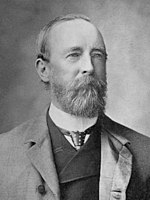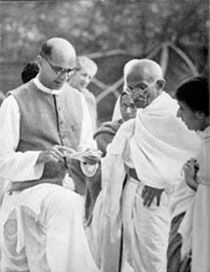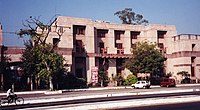The
Communist Party of India (Marxist) (abbreviated
CPI(M) or
CPM) is a
communist party in India. The party emerged from a split from the
Communist Party of India in 1964. The CPI(M) was formed at the Seventh Congress of the Communist Party of India held in Calcutta from October 31 to November 7, 1964. The strength of CPI(M) is concentrated in the states of
Kerala,
West Bengal and
Tripura. As of 2015, CPI(M) is leading the state government in Tripura. It also leads the
Left Front coalition of leftist parties. As of 2013, CPI(M) claimed to have 1,065,406 members.
CPI(M) is organised on the basis of
democratic centralism, a principle conceived by
Vladimir Lenin which entails democratic and open discussion on policy on the condition of unity in upholding the agreed upon policies. The highest body of the party is the
Politburo.
History
Formation of CPI (M)
CPI(M) emerged from a division within the
Communist Party of India (CPI). The undivided CPI had experienced a period of upsurge during the years following the
Second World War. The CPI led armed rebellions in
Telangana,
Tripura, and
Kerala. However, it soon abandoned the strategy of armed revolution in favour of working within the
parliamentary framework. In 1950
B. T. Ranadive, the CPI general secretary and a prominent representative of the radical sector inside the party, was demoted on grounds of left-adventurism.
Under the government of the
Indian National Congress party of
Jawaharlal Nehru, independent India developed close relations and a strategic partnership with the
Soviet Union. The Soviet government consequently wished that the Indian communists moderate their criticism towards the Indian state and assume a supportive role towards the Congress governments. However, large sections of the CPI claimed that India remained a semi-
feudal country, and that
class struggle could not be put on the back-burner for the sake of guarding the interests of Soviet trade and foreign policy. Moreover, the Indian National Congress appeared to be generally hostile towards political competition. In 1959 the central government intervened to impose
President's Rule in Kerala, toppling the
E.M.S. Namboodiripad cabinet (the sole non-Congress state government in the country).
During the war with China, a faction of the Indian Communists backed the position of the Indian government, while other sections of the party claimed that it was a conflict between a socialist and a capitalist state. The basis of difference in opinion between the two factions in CPI was ideological – about the assessment of Indian scenario and the development of a party programme. This difference in opinion was also a reflection of a similar difference at international level on ideology between the Soviet and Chinese parties. The alleged 'right wing' inside the party followed the Soviet path and put forward the idea of joining hands with the then ruling party – Indian National Congress. Whereas the faction of CPI which later became CPI(M) referred to this as a revisionist approach of class collaboration. It was this ideological difference which later intensified, coupled with the Soviet-Chinese split at the international level and ultimately gave birth to CPI(M).
Hundreds of CPI leaders, accused of being pro-Chinese, were imprisoned. Thousands of Communists were detained without trial. Those targeted by the state accused the pro-Soviet leadership of the CPI of conspiring with the Congress government to ensure their own hegemony over the control of the party.
In 1962
Ajoy Ghosh, the general secretary of the CPI, died. After his death,
S.A. Dange was installed as the party chairman (a new position) and E.M.S. Namboodiripad as general secretary. This was an attempt to achieve a compromise. Dange represented the rightist faction of the party and E.M.S. the leftist faction.
At a CPI National Council meeting held on 11 April 1964, 32 Council members walked out in protest, accusing Dange and his followers of "anti-unity and anti-Communist policies".
The leftist section, to which the 32 National Council members belonged, organised a convention in
Tenali, Andhra Pradesh 7 to 11 July. In this convention the issues of the internal disputes in the party were discussed. 146 delegates, claiming to represent 100,000 CPI members, took part in the proceedings. The convention decided to convene the 7th Party Congress of CPI in
Calcutta later the same year.
Marking a difference from the Dangeite sector of CPI, the Tenali convention was marked by the display of a large portrait of the
Chinese Communist leader
Mao Zedong.
At the Tenali convention a Bengal-based pro-Chinese group, representing one of the most radical streams of the CPI left wing, presented a draft programme proposal of their own. These radicals criticised the draft programme proposal prepared by
M. Basavapunniah for undermining
class struggle and failing to take a clear pro-Chinese position in the ideological conflict between the CPSU and CPC.
After the Tenali convention the CPI left wing organised party district and state conferences. In
West Bengal, a few of these meetings became battlegrounds between the most radical elements and the more moderate leadership. At the Calcutta Party District Conference an alternative draft programme was presented to the leadership by Parimal Das Gupta (a leading figure amongst far-left intellectuals in the party). Another alternative proposal was brought forward to the Calcutta Party District Conference by
Aziz ul Haq, but Haq was initially banned from presenting it by the conference organisers. At the Calcutta Party District Conference 42 delegates opposed M. Basavapunniah's official draft programme proposal.
At the Siliguri Party District Conference, the main draft proposal for a party programme was accepted, but with some additional points suggested by the far-left North Bengal cadre
Charu Majumdar. However,
Harekrishna Konar (representing the leadership of the CPI left wing) forbade the raising of the slogan
Mao Tse-Tung Zindabad (Long live Mao Tse-Tung) at the conference.
Parimal Das Gupta's document was also presented to the leadership at the West Bengal State Conference of the CPI leftwing. Das Gupta and a few other spoke at the conference, demanding the party ought to adopt the class analysis of the Indian state of the 1951 CPI conference. His proposal was, however, voted down.
The Calcutta Congress was held between 31 October and 7 November, at Tyagraja Hall in southern Calcutta. Simultaneously, the Dange group convened a Party Congress of CPI in
Bombay. Thus, the CPI divided into two separate parties. The group which assembled in Calcutta would later adopt the name 'Communist Party of India (Marxist)', to differentiate themselves from the Dange group. The CPI(M) also adopted its own political programme.
P. Sundarayya was elected general secretary of the party.
In total 422 delegates took part in the Calcutta Congress. CPI(M) claimed that they represented 104,421 CPI members, 60% of the total party membership.
At the Calcutta conference the party adopted a class analysis of the character of the Indian state, that claimed the Indian big
bourgeoisie was increasingly collaborating with
imperialism.
[12]
Parimal Das Gupta's alternative draft programme was not circulated at the Calcutta conference. However,
Souren Basu, a delegate from the far-left stronghold
Darjeeling, spoke at the conference asking why no portrait had been raised of Mao Tse-Tung along the portraits of other communist stalwarts. His intervention met with huge applauses from the delegates of the conference .
[12]
Name
CPI(M) is officially known as भारत की कम्युनिस्ट पार्टी मार्क्सवादी(Bharat ki Kamyunist Party Marksvadi) in Hindi, but it is often known as मार्क्सवादी कम्युनिस्ट पार्टी (Marksvadi Kamyunist Party, abbreviated MaKaPa) in press and media circles. During its initial years after the split, the party was often referred by different names such as 'Left Communist Party' or 'Communist Party of India (Left)'. The party has used the name 'Left' because CPI people were dubbed as rightist in nature for their support to Congress-Nehru regime. During Kerala Legislative Assembly elections of 1965 the party has adopted the name 'Communist Party of India (Marxist)' to obtain its election symbol from the Election Commission of India.
Communist Party of India (Marxist)
Bengali mural for the CPI(M) candidate in the Kolkata North West constituency in the 2004 Lok Sabha election,
Sudhangshu Seal.
Early years of CPI (M)
The CPI (M) was born into a hostile political climate. At the time of the holding of its Calcutta Congress, large sections of its leaders and cadres were jailed without trial. Again on 29–30 December, over a thousand CPI (M) cadres were arrested and detained, and held in jail without trial. In 1965 new waves of arrests of CPI(M) cadres took place in
West Bengal, as the party launched agitations against the rise in fares in the
Calcutta Tramways and against the then prevailing food crisis. Statewide general strikes and
hartals were observed on 5 August 1965, 10–11 March 1966 and 6 April 1966. The March 1966 general strike results in several deaths in confrontations with police forces.
Also in Kerala, mass arrests of CPI(M) cadres were carried out during 1965. In
Bihar, the party called for a
Bandh (general strike) in
Patna on 9 August 1965 in protest against the Congress state government. During the strike, police resorted to violent actions against the organisers of the strike. The strike was followed by agitations in other parts of the state.
P. Sundaraiah, after being released from jail, spent the period of September 1965 – February 1966 in Moscow for medical treatment. In Moscow he also held talks with the CPSU.
The Central Committee of CPI(M) held its first meeting on 12–19 June 1966. The reason for delaying the holding of a regular CC meeting was the fact that several of the persons elected as CC members at the Calcutta Congress were jailed at the time.A CC meeting had been scheduled to have been held in
Trichur during the last days of 1964, but had been cancelled due to the wave of arrests against the party. The meeting discussed tactics for electoral alliances, and concluded that the party should seek to form a broad electoral alliances with all non-reactionary opposition parties in West Bengal (i.e. all parties except Jan Sangh and Swatantra Party). This decision was strongly criticised by the
Communist Party of China, the
Party of Labour of Albania, the
Communist Party of New Zealand and the radicals within the party itself. The line was changed at a National Council meeting in
Jullunder in October 1966, where it was decided that the party should only form alliances with selected left parties.
Naxalbari uprising
At this point the party stood at crossroads. There were radical sections of the party who were wary of the increasing parliamentary focus of the party leadership, especially after the electoral victories in West Bengal and Kerala. Developments in China also affected the situation inside the party. In West Bengal two separate internal dissident tendencies emerged, which both could be identified as supporting the Chinese line. In 1967 a peasant uprising broke out in
Naxalbari, in northern West Bengal. The insurgency was led by hardline district-level CPI(M) leaders
Charu Majumdar and
Kanu Sanyal. The hardliners within CPI(M) saw the Naxalbari uprising as the spark that would ignite the Indian revolution. The Communist Party of China hailed the Naxalbari movement, causing an abrupt break in CPI(M)-CPC relations. The Naxalbari movement was violently repressed by the West Bengal government, of which CPI(M) was a major partner. Within the party, the hardliners rallied around an
All India Coordination Committee of Communist Revolutionaries. Following the 1968
Burdwan plenum of CPI(M) (held on 5–12 April 1968), the AICCCR separated themselves from CPI(M). This split divided the party throughout the country. But notably in West Bengal, which was the centre of the violent radicalist stream, no prominent leading figure left the party. The party and the
Naxalites (as the rebels were called) were soon to get into a bloody feud.
In Andhra Pradesh another revolt was taking place. There the pro-Naxalbari dissidents had not established any presence. But in the party organisation there were many veterans from the Telangana armed struggle, who rallied against the central party leadership. In Andhra Pradesh the radicals had a strong base even amongst the state-level leadership. The main leader of the radical tendency was
T. Nagi Reddy, a member of the state legislative assembly. On 15 June 1968 the leaders of the radical tendency published a press statement outlining the critique of the development of CPI(M). It was signed by T. Nagi Reddy, D.V. Rao, Kolla Venkaiah and
Chandra Pulla Reddy. In total around 50% of the party cadres in Andhra Pradesh left the party to form the
Andhra Pradesh Coordination Committee of Communist Revolutionaries, under the leadership of T. Nagi Reddy.
Dismissal of United Front governments in West Bengal and Kerala
In November 1967, the West Bengal United Front government was dismissed by the central government. Initially the Indian National Congress formed a minority government led by
Prafulla Chandra Ghosh, but that cabinet did not last long. Following the proclamation that the United Front government had been dislodged, a 48-hour hartal was effective throughout the state. After the fall of the Ghosh cabinet, the state was put under President's Rule. CPI(M) launched agitations against the interventions of the central government in West Bengal.
The 8th Party Congress of CPI(M) was held in
Cochin, Kerala, on 23–29 December 1968. On 25 December 1968, whilst the congress was held, 42
Dalits were burned alive in the Tamil village of
Kizhavenmani. The massacre was a retaliation from landlords after Dalit labourers had taken part in a CPI(M)-led agitation for higher wages.
The United Front government in Kerala was forced out of office in October 1969, as the CPI, RSP, KTP and Muslim League ministers resigned. E.M.S. Namboodiripad handed in his resignation on 24 October. A coalition government led by CPI leader
C. Achutha Menon was formed, with the outside support of the
Indian National Congress.
Elections in West Bengal and Kerala
Fresh elections were held in West Bengal in 1969. CPI(M) contested 97 seats, and won 80. The party was now the largest in the West Bengal legislative. But with the active support of CPI and the Bangla Congress, Ajoy Mukherjee was returned as Chief Minister of the state. Mukherjee resigned on 16 March 1970, after a pact had been reached between CPI, Bangla Congress and the Indian National Congress against CPI(M). CPI(M) strove to form a new government, instead but the central government put the state under President's Rule.
In Kerala, fresh elections were held in 1970. CPI(M) contested 73 seats and won 29. After the election Achutha Menon formed a new ministry, including ministers from the Indian National Congress.
Outbreak of war in East Pakistan
In 1971
Bangladesh (formerly
East Pakistan) declared its independence from
Pakistan. The Pakistani military tried to quell the uprising. India intervened militarily and gave active backing to the
Bangladeshi resistance. Millions of Bangladeshi refugees sought shelter in India, especially in West Bengal.
At the time the radical sections of the Bangladeshi communist movement were divided into many
factions. Whilst the pro-Soviet
Communist Party of Bangladesh actively participated in the resistance struggle, the pro-China communist tendency found itself in a peculiar situation as China had sided with Pakistan in the war. In Calcutta, where many Bangladeshi leftists had sought refuge, CPI(M) worked to co-ordinate the efforts to create a new political organisation. In the fall of 1971 three small groups, which were all hosted by the CPI(M), came together to form the
Bangladesh Communist Party (Leninist). The new party became the sister party of CPI(M) in Bangladesh.
Political ideology and stances
Article VI, Section 3 of the 2001 Constitution lays out certain positions as non-negotiable:
"revolutionary vanguard of the working class of India. Its aim is socialism and communism through the establishment of the state of
dictatorship of the proletariat. In all its activities the Party is guided by the philosophy and principles of
Marxism–Leninism which shows to the toiling masses the correct way to the ending of exploitation of man by man, their complete emancipation. The Party keeps high the banner of proletarian internationalism".
[26]
























